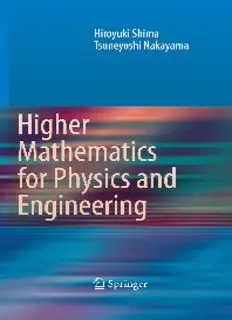Table Of Content
Higher Mathematics for Physics
and Engineering
·
Hiroyuki Shima Tsuneyoshi Nakayama
Higher Mathematics for
Physics and Engineering
123
Dr.HiroyukiShima,AssistantProfessor Dr.TsuneyoshiNakayama,Professor
DepartmentofAppliedPhysics ToyotaPhysicalandChemicalResearchInstitute
HokkaidoUniversity Aichi480-1192,Japan
Sapporo060-8628,Japan [email protected]
[email protected]
ISBN978-3-540-87863-6 e-ISBN978-3-540-87864-3
DOI10.1007/b138494
SpringerHeidelbergDordrechtLondonNewYork
LibraryofCongressControlNumber:2009940406
(cid:2)c Springer-VerlagBerlinHeidelberg2010
Thisworkissubjecttocopyright.Allrightsarereserved,whetherthewholeorpartofthematerialis
concerned,specificallytherightsoftranslation,reprinting,reuseofillustrations,recitation,broadcasting,
reproductiononmicrofilmorinanyotherway,andstorageindatabanks.Duplicationofthispublication
orpartsthereofispermittedonlyundertheprovisionsoftheGermanCopyrightLawofSeptember9,
1965,initscurrentversion,andpermissionforusemustalwaysbeobtainedfromSpringer.Violations
areliabletoprosecutionundertheGermanCopyrightLaw.
Theuseofgeneraldescriptivenames,registerednames,trademarks,etc.inthispublicationdoesnot
imply,evenintheabsenceofaspecificstatement,thatsuchnamesareexemptfromtherelevantprotective
lawsandregulationsandthereforefreeforgeneraluse.
Coverdesign:eStudioCalamarSteinen
Printedonacid-freepaper
SpringerispartofSpringerScience+BusinessMedia(www.springer.com)
To our friends and colleagues
Preface
Owing to the rapid advances in the physical sciences and engineering, the de-
mand for higher-level mathematics is increasing yearly. This book is designed
foradvancedundergraduatesandgraduatestudentswhoareinterestedinthe
mathematical aspects of their own fields of study. The reader is assumed to
have a knowledge of undergraduate-level calculus and linear algebra.
There are any number of books available on mathematics for physics and
engineering but they all fall into one of two categories: the one emphasizes
mathematicalrigorandtheexpositionofdefinitionsortheorems,whereasthe
other is concerned primarily with applying mathematics to practical prob-
lems.Webelievethatneitheroftheseapproachesaloneisparticularlyhelpful
to physicists and engineers who want to understand the mathematical back-
ground of the subjects with which they are concerned. This book is different
in that it provides a short path to higher mathematics via a combination of
these approaches. A sizable portion of this book is devoted to theorems and
definitions with their proofs, and we are convinced that the study of these
proofs,whichrangefromtrivialtodifficult,isusefulforagraspofthegeneral
ideaofmathematical logic.Moreover,severalproblemshavebeenincludedat
the end of each section, and complete solutions for all of them are presented
in the greatest possible detail. We firmly believe that ours is a better peda-
gogical approach than that found in typical textbooks, where there are many
well-polished problems but no solutions.
This book is essentially self-contained and assumes only standard under-
graduate preparation such as elementary calculus and linear algebra. The
first half of the book covers the following three topics: real analysis, func-
tional analysis, and complex analysis, along with the preliminaries and four
appendixes. Part I focuses on sequences and series of real numbers of real
functions, with detailed explanations oftheir convergence properties.Wealso
emphasize the concepts of Cauchy sequences and the Cauchy criterion that
determine the convergence of infinite real sequences. Part II deals with the
theory of the Hilbert space, which is the most important class of infinite vec-
torspaces.ThecompletenesspropertyofHilbertspacesallowsonetodevelop
VIII Preface
various types of complex orthonormal polynomials, as described in the mid-
dle of Part II. An introduction to the Lebesgue integration theory, a subject
of ever-increasing importance in physics, is also presented. Part III describes
the theory of complex-valued functions of one complex variable. All relevant
elements including analytic functions, singularity, residue, continuation, and
conformal mapping are described in a self-contained manner. A thorough un-
derstanding of the fundamentals treated is important in order to proceed to
more advanced branches of mathematical physics.
In the second half of the volume, the following three specific topics are
discussed: Fourier analysis, differential equations, and tensor analysis. These
three are the most important subjects in both engineering and the physical
sciences,buttheirrigorousmathematicalstructureshavehardlybeencovered
inordinarytextbooks.Weknowthatmathematicalrigorisoftenunnecessary
forpracticaluse.However,theblindusageofmathematicalmethodsasatool
may lead to a lack of understanding of the symbiotic relationship between
mathematics and the physical sciences. We believe that readers who study
the mathematical structures underlying these three subjects in detail will ac-
quire a better understanding of the theoretical backgrounds associated with
their own fields. Part IV describes the theory of Fourier series, the Fourier
transform, and the Laplace transform, with a special emphasis on the proofs
of their convergence properties. A more contemporary subject, the wavelet
transform, is also described toward the end of Part IV. Part V deals with or-
dinary and partial differential equations. The existence theorem and stability
theory for solutions, which serve as the underlying basis for differential equa-
tions,aredescribedwithrigorousproofs.PartVIisdevotedtothecalculusof
tensorsintermsofbothCartesianandnon-Cartesiancoordinates,alongwith
the essentials of differential geometry. An alternative tensor theory expressed
in terms of abstract vector spaces is developed toward the end of Part VI.
The authors hope and trust that this book will serve as an introductory
guide for the mathematical aspects of the important topics in the physical
sciences and engineering.
Sapporo, Hiroyuki Shima
November 2009 Tsuneyoshi Nakayama
Contents
1 Preliminaries .............................................. 1
1.1 Basic Notions of a Set.................................... 1
1.1.1 Set and Element .................................. 1
1.1.2 Number Sets...................................... 3
1.1.3 Bounds .......................................... 3
1.1.4 Interval .......................................... 4
1.1.5 Neighborhood and Contact Point.................... 5
1.1.6 Closed and Open Sets.............................. 7
1.2 Conditional Statements .................................. 9
1.3 Order of Magnitude...................................... 10
1.3.1 Symbols O, o, and ∼............................... 10
1.3.2 Asymptotic Behavior .............................. 11
1.4 Values of Indeterminate Forms ............................ 12
1.4.1 l’Hoˆpital’s Rule ................................... 12
1.4.2 Several Examples.................................. 13
Part I Real Analysis
2 Real Sequences and Series ................................. 17
2.1 Sequences of Real Numbers ............................... 17
2.1.1 Convergence of a Sequence ......................... 17
2.1.2 Bounded Sequences................................ 18
2.1.3 Monotonic Sequences .............................. 19
2.1.4 Limit Superior and Limit Inferior.................... 21
2.2 Cauchy Criterion for Real Sequences ....................... 25
2.2.1 Cauchy Sequence.................................. 25
2.2.2 Cauchy Criterion.................................. 26
2.3 Infinite Series of Real Numbers............................ 29
2.3.1 Limits of Infinite Series ............................ 29
2.3.2 Cauchy Criterion for Infinite Series .................. 31

